- Would you say that the job market for brand journalists is fairly fluid? That is, could you find work writing for other start-ups, websites or publications using the same skill set you’ve cultivated at Red Hat?
- Do you notice yourself writing differently for online publications than you would for physical ones? In terms of word choice and layout as well as length?
- Would you recommend that others try to get a job in the brand journalism field as well? Do you think it is still growing?
Author: rroche
VR Reflection
During the virtual reality demo in class today I experienced a border conflict taking place in Arizona. A fence had been built dividing a city, leaving half in the U.S. and half in Mexico. The story of how a young Mexican boy was shot over ten times through the fence by border patrol officers was told through narration, images and video of the area. Footage from a helicopter, the Mexican side and the U.S. side was shown to allow viewers to completely form an image of the area within their own minds.
I think that VR will add a whole new dimension to the publishing field. Just like we have book publishers like RandomHouse, I think that there will be VR specific publishers specializing in the field, seeking out talented VR producers and filmers to add to their teams. As VR becomes more popular I think that its section of the publishing industry will only grow.
Based on what I saw today I do really think VR can evoke empathy. Without having a visual representation of the scene where the shooting took place, it would be hard to understand the sort of environmental tension that the fence produced and the violence it creates. Both sides of the story were explained and it was easy to empathize with both the border patrol and the boy’s family. The added level of immersion that VR allows makes its ability to create empathy even stronger.
Transportation
Transportation in Baltimore
Transportation has been a major concern here at AWE. We want to make sure that you are able to navigate Baltimore efficiently as well as safely. This page features information regarding mass transit here in Baltimore. Information on the Metro, Light Rail and Bus systems is provided below, along with a some helpful tips.
Baltimore Light Rail and Metro Map
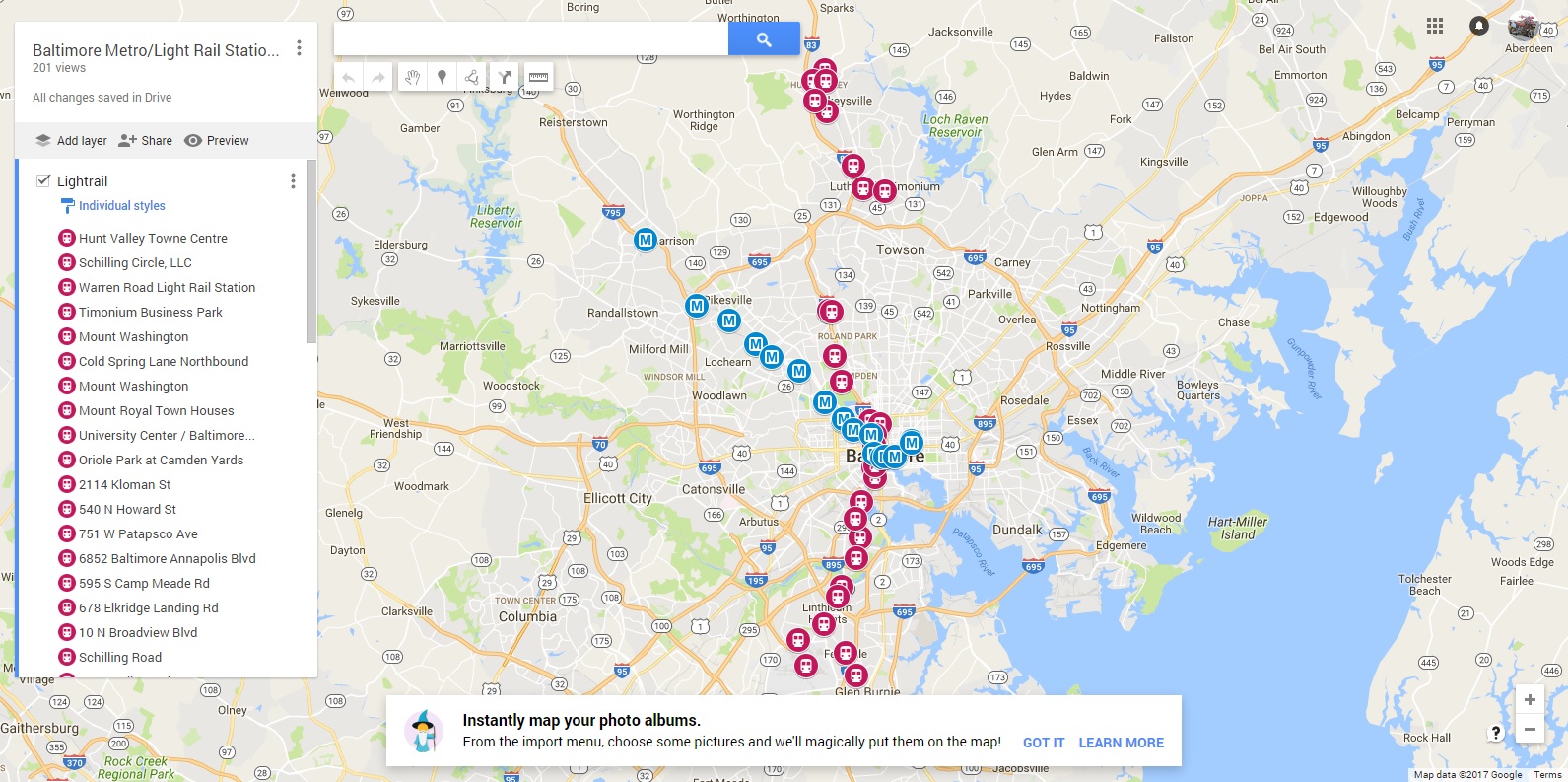
Light Rail
The light rail is an above ground, electric train that runs from BWI Airport, through the heart of Baltimore city, all the way into Hunt Valley. It also connects to Penn Station and several bus stops, making it a great primary source of public transportation. The route parallels highway I-83 and runs North to South. The train, runs on dedicated tracks allowing for it to often move faster than congested, rush hour traffic.
Stops are marked on charts above the train’s doors in a very basic order. A dot on a yellow line represents each stop the train will make, the operator will announce each stop as the train approaches it. It is important to pay attention to what stops are close by, or will be coming up since if you miss a stop, you’ll need to get off and catch another train going the opposite direction.
Each light rail station has tracks running in both north and south directions. Above the tracks there will be an automated display that features the estimated arrival times of approaching trains, as well as the direction that side of the tracks runs. Again, paying attention to North/South is important. The electronic signs also display the time, date, and stop name to help you keep your bearings on your location. Near the automated machines where tickets are purchased there is usually a large map of the light rail system with a helpful “you are here” circle to mark the location of the station you are nearest. This can also be helpful in planning your trips around the city.
Stations
Many of the stations have parking lots as well as bus stops allowing for easy connections and parking when journeying into the city. There will be automated machines near each station at which you select your trip options and pay for your ticket. You will want to use smaller bills and/or exact change to pay for your tickets to keep the process simple. You are able to move freely amongst the cars and can sit wherever there is space available, just remember that the sideways bench style seats, closest to the doors, are prioritized for the handicapped.

Hours
Monday – Friday
5:00 a.m. – 12:00 a.m.
Saturday
6:00 a.m. – 12:00 p.m.
Sunday
11:00 a.m. – 7 p.m.
Metro
The Baltimore Metro serves as a connector from the Owings Mills area of Baltimore County to downtown Baltimore. The train runs both above and below ground, with stations above and below ground as well. Just like the light rail system, you will purchase your tickets at automated ticket booths positioned at each station. The turn styles near the tracks have a slot to accept and scan your ticket, allowing for entry.
Upcoming stops are announced over the intercom by the operator on board the train. Stations also usually feature display boards with instructions on connecting to other bus or light rail routes nearby.
Hours
Monday – Friday 5:00 am to 12:00 am
Saturday – Sunday 6:00 am to 12:00 am
Bus
Unlike the metro or light rail, you will not buy your bus ticket until you are on the bus itself. Bus stops are marked by blue and white signs on poles that stick out of the sidewalk, often but not always near intersections or busy roads. As you step up onto the bus you’ll insert your payment into machine that looks very similar to the ones you’ll see at a light rail or metro station. This machine is very close to the bus driver, who can help you if you have any problems. You will want to use smaller bills and/or exact change to pay for your ticket to keep the process simple and quick. Remember there will probably be people behind waiting to get on and pay as well. You’ll collect your change and then have a seat in an open spot.
Bus fares are the same prices as light rail or metro tickets. If a day pass is purchased, the rider can take as many rides as they want to, on any form of local transportation, making this a good option if a bus ride is combined with light rail or Metro usage.
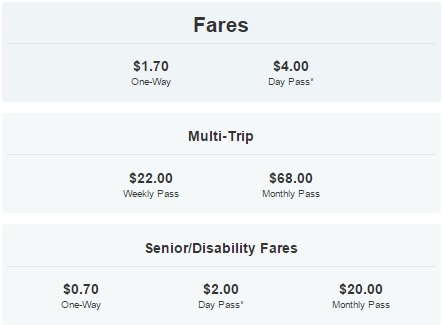
BWI
The BWI airport is a large airport south of Baltimore City. Various flights both nationally and internationally enter and exit through this major transportation hub. It is usually a good idea to try to arrive 3 hours before your flight is scheduled to take off. Due to its size, it may take you awhile to orient yourself appropriately once you are inside. You will want to make sure to enter the correct terminal, and then enter the line to begin being checked by security. Once past the security line, you can move about freely, just remember to keep track of the time so you do not miss your flight!
Transportation Connectivity
There are both light rail and bus stops at BWI to help you travel either to or from the airport from the surrounding areas. A taxi from the airport to downtown Baltimore is an estimated $35.00, while this is more expensive then a bus or light rail ticket, the direct route is certainly nice and taxi’s are usually waiting in lines outside of the terminals/entrances. An alternative to a taxi is the airport shuttle service. These shuttles are generally less expensive than the taxi, but are also less direct in their routes.
MARC Train/AMTRAK
The MARC Train system runs in and out of Penn Station in Mt. Royal. The light rail and bus both connect to this station, allowing for easy access to this system. For those looking to reach Baltimore from other east coast cities or commute further distances, the MARC train and AMTRAK provide many options.
Penn Station also can be easily accessed by light rail, bus or taxi.
https://mta.maryland.gov/marc-train
3 Questions for Chris Friend
- Are there any other open-access online journals you were inspired by (or wanted to do better then) when creating the site?
- Have you faced any adverse pressure or challenges from more traditional academics due to the open-access/progressive nature of the site?
- Did you build the site with the knowledge that users would use tools like hypothesis to discuss articles in deeper depth then the comments section allows? Do you like the opportunities hypothesis provides for discussion/annotation?
Annotated Bibliography – Transportation
Bose, Pablo. “Transportation, Equity, and Communities at Risk: Refugee Population and Transportation Accessibility in Vermont.” University of Vermont Transportation Research Center, Mar. 2011, pp. 1–67. Google, www.uvm.edu/~transctr/research/trc_reports/UVM-TRC-10-018.pdf. Accessed 20 Mar. 2017.
The author of this article is Pablo Bose, a professor at the University of Vermont. He has done a fairly large amount of research on helping refugees/asylees navigate a foreign country using mass transit. One of the primary intended audiences is the Vermont state government, but anyone looking to learn more or help with the problem is also targeted.
The strengths of this article are its suggestions, possibilities and analysis regarding the transportation problems refugees’ face. The information does support out project as many Vermont refugees face similar problems that are comparable to those working with AWE. This information is highly relevant to our topic.
“Maryland Transportation Resource Information Point | MDTrip.” Maryland Transportation Resource Information Point – MDTrip.org, www.mdtrip.org/. Accessed 20 March. 2017
The author of this article appears to be the Maryland Transit Association, they speak with authority as the site breaks down and explains how to use their own services. The primary intended audience is anyone looking to navigate Maryland using public transportation. The secondary audience would be someone looking to help others navigate Maryland’s transit system.
The strengths are mainly the amount of information regarding the MTA and how it works, as well as how to use it. The information does support our work with AWE as it would help asylees navigate the city. The material is relevant to our class project as it offers both maps and guides to navigating the greater Baltimore area.
Jones, David W. Mass Motorization + Mass Transit : An American History and Policy Analysis. Indiana University Press, 2008. EBSCOhost, ezproxy.stevenson.edu/login?url=http://search.ebscohost.com/login.aspx?direct=true&db=nlebk&AN=242096&site=eds-live&scope=site/Accessed 3 April, 2017.
The author of this article is David Jones, a researcher focusing on the social and economic forces surrounding mass transit, specifically in the United States. He explores the various legislative, economic and cultural aspects of mass transit, how these factors effect transit and how transit also effects these factors.
The strengths of this source are the details and lengths he went to in his research. The weakness is that it doesn’t relate specifically to Baltimore or the refugee crisis, it is more historical in its perspective. This lack of direct relation means that this may be a good source to fall back on, but it isn’t particularly relevant to our cause.
Book Traces with Dr. Andrew Stauffer
The Book Traces presentation in the library by Dr. Stauffer was pretty incredible. The amount of history that can be extracted from notes within the marginalia of Victorian-era books is very deep and thanks to modern technologies like google, able to be explored. He estimated that 12.5% of Victorian-era books contain significant historical marginalia. Dr. Stauffer’s process of looking up who people were and their relationships based on their marginalia so many years later almost seems like science-fiction.
The frequency of physical artifacts found within the books was also something really unusual that caught my attention. Sewing needles, locks of hair, and dolls as well as botanical insertions are all common within these older books. The botanical insertion portion was especially interesting as we were able to follow how a habit or action by people (inserting a flower into a book) became practice by publisher’s incorporating printed flowers and other botanical designs into the margins and illustrations where people normally would press one in. This practice evolved into layers of images being incorporated into the works of writer’s like Wordsworth. Images in works like that were connected to other images that sprawled over pages in a psychedelic style. I guess they could be considered meta-illustrations.
The social-historical aspect of the event was immense as well. The social function and form of annotation as a type of communication similar to a modern day email was very cool. Notes to lovers and friends were scrawled on pages or passages that reminded people of each other. Following the Victorian-era books also came pre-annotated in a sense as a result of the practice. Life stages (specifically those of women) were included in books with parts left blank for a mother to fill out for a daughter as she grew up.
The major role of books within peoples lives during the Victorian-era was put into perspective as a result of Stauffer’s work. Books were not just educational, religious or recreational, they were major social tools as well. Book traces open-source accessibility is a wonderful layout for a really intriguing project.
Asylee Transportation Pitch
As discussed by Tiffany Nelms during our in class meeting and during AWE’s grant request, transportation is a major issue facing the asylees living in Baltimore. Navigating the public transit system in Baltimore can be intimidating and expensive, as well as confusing if one is unfamiliar with routes, connections and methods of travel.

Baltimore’s MTA has three main modes of transportation, the metro, bus and light rail for commuting within the city and county region. The MARC train leaving from Penn station in Mt. Royal (north of the inner harbor) allows for travel along much of the east coast. In this case, its routes to Washington D.C. and Philadelphia are of the most interest as it would allow for asylees to get to work should they happen to find employment in either of these locations. An easy to use website section simplifying the cluttered MTA version of Baltimore’s mass transit department would be of great help to AWE. It would be something available not only to those directly involved with AWE, but also a virtual hub for other asylees in the greater Baltimore area looking for help with transportation.

The intended audience is asylees unfamiliar with Baltimore’s mass transit. They may or may not be involved with AWE. It would also include asylees looking to come to Baltimore to take advantage of resources like AWE through transportation methods like the MARC train to other cities or the lightrail to pick them up from BWI airport.
Incorporated media should primarily include simplified maps and a guide to landmarks and locations within Baltimore City and County. A currency table may be helpful as public transportation prices vary based on the type of transit used as well as the length or frequency of the trips. Making sure the asylees are comfortable with the process of buying tickets at stations and navigating would be a priority. I’m not sure about the extent to which we can make these features interactive, I think the primary focus should be accessibility rather than flashiness from things like traceable routes.
A project done by the University of Vermont may provide insight into the development of this web feature through their research on the transportation needs and challenges faced by refugees in the North Eastern United States. Even if it does not add much to our web page, it may be an important asset for AWE to gain a better understanding of the challenges refugees face.
http://www.uvm.edu/~transctr/research/trc_reports/UVM-TRC-10-018.pdf
The MTA website is overwhelming in its layout and information presentation but will need to be consulted in order to provide accurate information on the updated AWE site.
http://www.mdtrip.org/maps-schedules-fares/?gclid=CNiFvJWL6NICFV5MDQodazsKvQ
some sort of table representing US currency and the corresponding amounts and/or combinations required to purchase tickets for MTA transit may be helpful as well.
(couldn’t figure out how to cite these properly, sorry!)
Letter Press(ure)
The letterpress demo we did as a class last week was really eye opening. I had no idea that in the past, printing was such an involved and time consuming process. Just setting the type was complex in itself. The use of em-quads to space the text block and create margins required planning that I had never considered. Having to proofread the sentence with it positioned upside down was also mind boggling. The amount of focus that early printing press workers possessed to compose their print successfully is very impressive. It’s easy to take modern word processing features like spellchecking and formatting for granted. I never realized how much time these features save us when writing or editing documents.
In addition to the extra mental acuity required by early print workers, they also needed to demonstrate a healthy amount of dexterity to make it through the day. Handling the composing stick, tracking down specific letters and punctuation in the type-case and transferring the text block onto the printer all required fine motor skills and coordination. At any time one wrong move would have sent tons of small pieces flying. This would have required even more time for pieces to be tracked down and re-organized. Once the actual printing process had begun it was also important to keep hands, hair and clothing away from the rotating machinery and out of the printed work.
The printing press itself was a mechanical work of art. Multiple rollers spread the ink across themselves before coating the organized moveable type. The use of “furniture” allowed for the text to be spaced appropriately before the paper was rolled across, transferring the ink to the page. The machine had pedals, handles and switches that had to be used to print successfully. I imagine that a larger scale printing operation even more complex machinery to operate on a daily basis. In comparison a modern printer seems so high-tech in its ability to quickly and cleanly print, scan or copy. What used to be a high pressure job is now easily accessible and user friendly thanks to word processing programs and laser printers.
5 Questions for Tiffany Nelms
1) Would you be interested in having some sort of how-to or guide section on the new website that addresses the transportation concern? Bus/Lightrail/Metro routes and instructions could be featured prominently.
2) Have you considered using a donation processing service other than BluePay? Do you think that possible donors would be more inclined to give if you used something they were more familiar with, or already have accounts with such as PayPal?
3) How much of a social media presence does AWE have and do you consider expanding that a priority?
4) What do you think of the idea of having a website section that features local, refugee friendly businesses, areas or activities?
5) Are there any other refugee foundations/organizations that you are directly partnered with and would want to mention on the website?
Rhetorical Analysis of Heifer.org
Rhetorical Analysis Parts 1 and 2
Audience
The primary intended audience of Heifer.org seems to mainly be people looking to donate to the Heifer foundation. These possible donors are likely people looking to end world hunger. In addition to attracting potential funding, the website also aims to inform visitors about their mission and the issue of world hunger. A secondary audience of people trying to learn more about world hunger and its effects both locally and internationally is also reached. The website is only offered in the English language implying that its intended audience is English speakers. Based on their location here in the United States, one could further narrow down Heifer’s intended audience to being possible American donors or Americans researching Heifer and world hunger. There is a sub-menu allowing for donations to be placed that specifically go to empowering women. This adds another dimension to Heifer’s possible audience as well as their purpose. Both are broadened to support of women and ending hunger as well as donors interested in contributing to either cause.
Purpose
This website’s primary purpose is to raise money for the Heifer Foundation and the various projects and charitable actions they provide. As soon as a visitor logs on to the site they are presented with this pop-up screen that pushes them to identify as a donor. 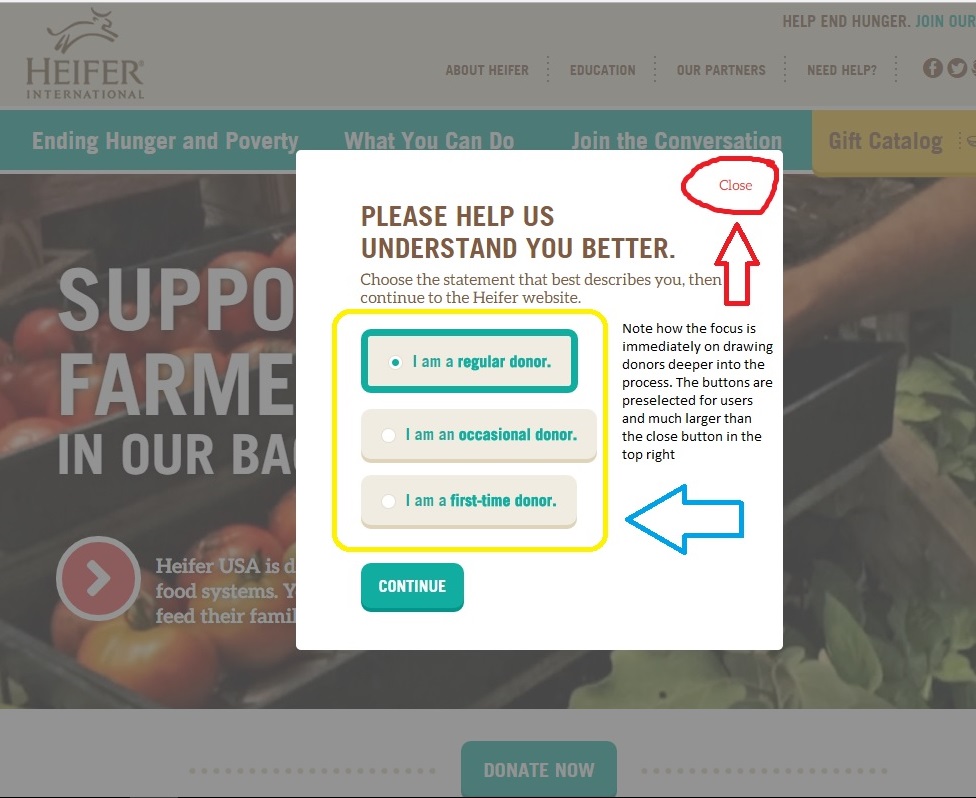
Due to the immense amount of information available on Heifer’s website, their secondary purpose seems to be bringing awareness to the issue of hunger on both international and local scales. The tertiary purpose seems to be informing the public with information regarding how they are working against world hunger. This is supported by Heifer dedicating a large portion of their website to describing the methods they use to provide their services to those in need.
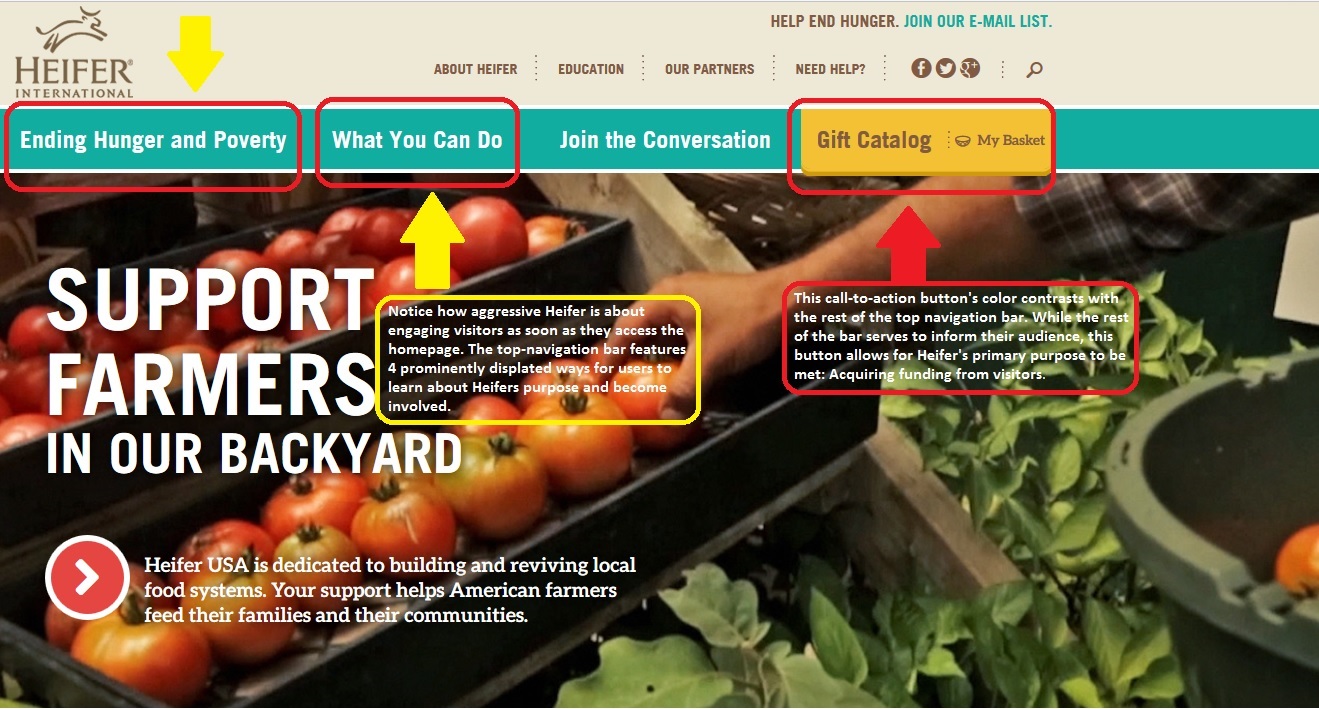
Context
If you put heifer into your preferred search engine their website is usually among the top results and features a brief statement to provide some context to visitors before they click the lnk.

Heifer.org fully utilizes its online medium to present itself to readers. The text is laid out in an interactive format on the Heifer website. Readers navigate maps and other interactive graphics and menus to learn more about Heifer’s work, the issues surrounding hunger and nutrition worldwide as well as possible ways to contribute to Heifer in order to aid them in their mission.
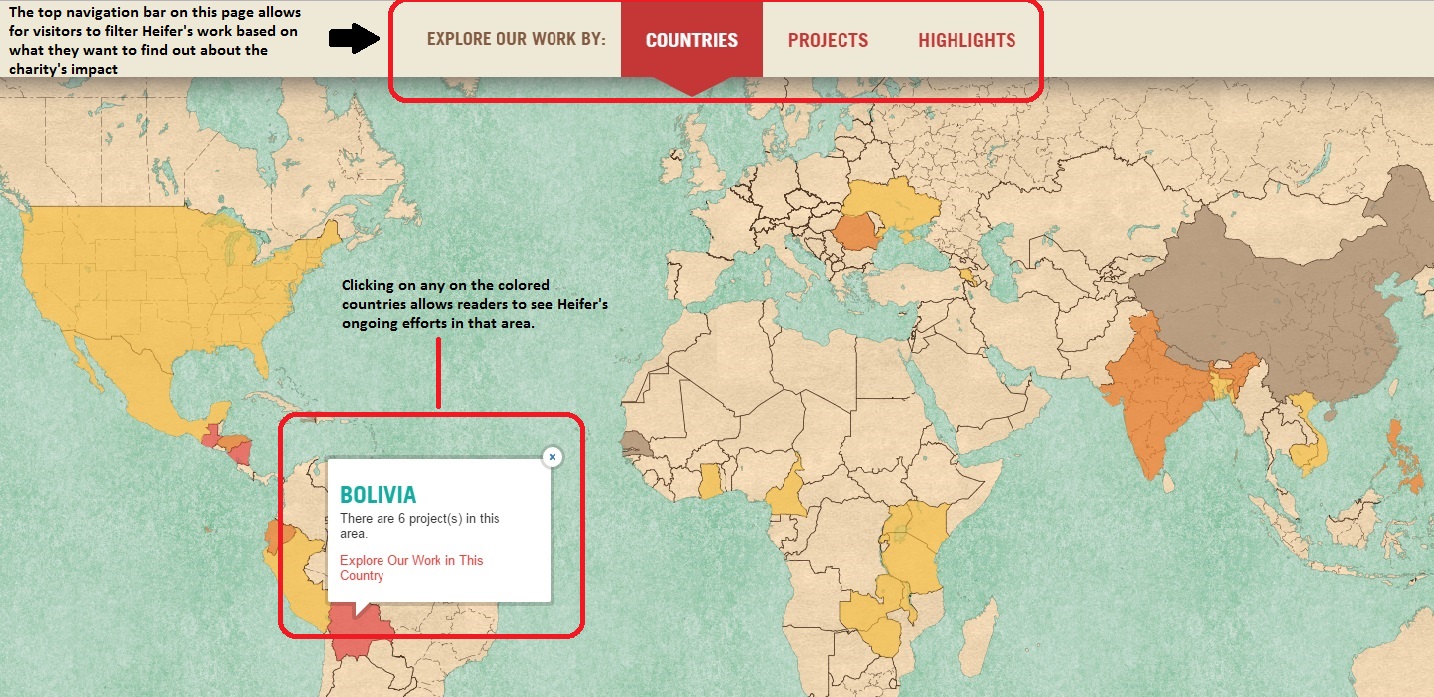
These information graphics are easy to use and stand especially when compared to the information architecture on other sites. The designers of Heifer’s website spent a lot of time allowing a user to get lost in their information without becoming disoriented. No matter how deep into the charity projects or catalog you go, the top-navigation bar allows a user to keep their sense of direction within the site.
Heifer’s online context allows them to easily convey large amounts of info about themselves and allows for easy donations and purchases from their online store via credit or debit cards from visitors. Being an online publication/foundation with credit card processing capabilities allows for much easier access to customer/donor funds.

Notice how the donation slider comes preset to the most expensive standardized amount on their donation pages. Their online presence allows for them to draw donors in for larger sums than an in person, door-to-door charity campaign would simply by their ability to process credit cards.
Genre
The Heifer website most closely falls into the genre of online charity organizations. The amount of information on the site also adds an educational/informational aspect to it. Readers are constantly presented with facts about the issues of world hunger and different ways that Heifer is working to end it. In addition to a constant information screen, visitors are frequently and boldly prompted to donate via pop-ups and boldly placed call-to-action buttons. Small touches like calling the “cart” the “basket” and letting visitors choose who/where they donate to make the website feel more personal and less generic.

The careful, gentle wording and is an effective quality in a website that’s main purpose is to acquire donations. The warm colors featured by Heifer also aid in this feeling of comfort. Even the cooler colors like blues and greens used on their front page are soft and provide a gentle but effective contrast against their call-to-action buttons.
Font
Most of Heifers text is written in brief, easy to read blurbs in a font that does not use any serifs to possibly disorient dyslexic visitors. The writing is well spaced and formatted well enough that a reader’s eye naturally finds the next line or latches onto the next blurb down the screen.
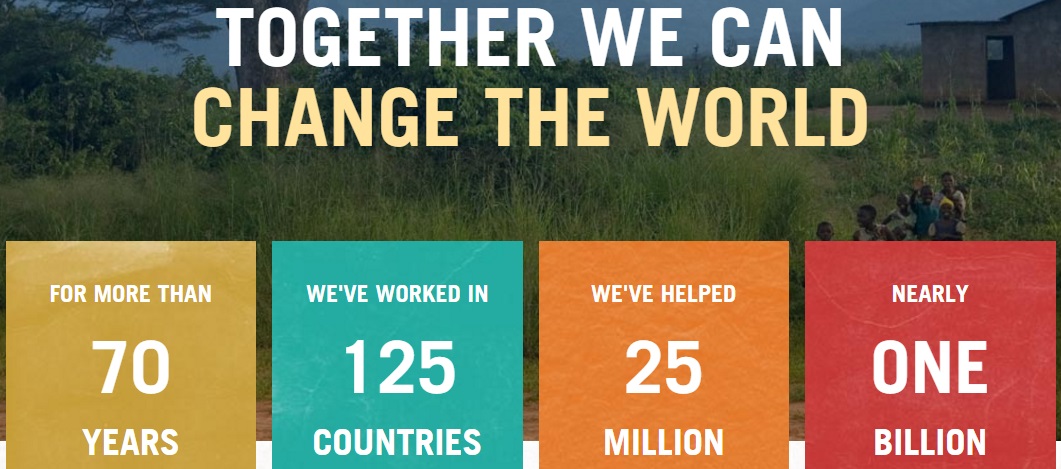
The above font is easily readable , the layout is simple and the message is clear. The colors are all very muted but distinguishable against one another and allow for the plain white text to be easily read.
Author
No actual author is given credit or mentioned in any of the articles or parts of the website. The implied author is one that cares deeply about the work of Heifer and wants to inform the readers as heavily as possible about their work and the benefits that a donation will have on the work.
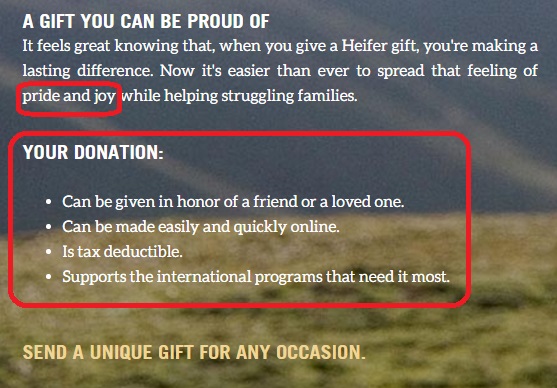
The author of the above image has a clear and persuasive voice. The benefits a donation would have are clearly listed for visitor’s through the use of persuasive language like “feeling of pride and joy” and “you’re making a lasting difference.” That firm but persuasive voice makes readers want to please that author and donate to Heifer.org.
Rhetorical Analysis Part 3
The primary audience for heifer.org is possible donor’s. These are visitors who come to the site to make a donation. Though the Heifer organization is a charity, it is run like a business and acquiring funding is still their primary goal, which makes potential donors their primary audience. Due to the immense amount of information also featured on the Heifer site, they reach a secondary audience of people who are looking to learn more about issues like world hunger and their effects on both a local and international scale. Countless pages of information on these topics are featured on the site and feature easy to read graphics like graphs, maps and photos to show readers what hunger looks like, how it affects people and what Heifer does to help. The primary purpose of Heifer’s site as mentioned above is to acquire funding, which does make them biased in their mission, though it is not necessarily negative bias. The side of the argument that Heifer presents and favors is their side. Heifer wants you to donate to them, rather than donate to a local food bank or other charity. It is an understandable bias to have considering that Heifer’s site functions to run a truly massive international charity.
The online medium utilized by heifer.org is what makes running their charity on such a massive scale possible. The website layout makes it super easy for donations to be taken by credit card processing software and allows for them to also run an online store to help fund their projects. Tons of pictures, graphics and interactive menus engage readers and all seem to somehow lead back to a donation button without Heifer seeming pushy or too assertive. These multi-modal elements make for a smooth and interesting user experience as readers are able to absorb cultural facts and statistics about hunger while they contemplate making their donations. Links and tags to other articles and pages on Heifer.org are abundant and a user can spend hours browsing the sites dense content.
When creating this rhetorical analysis I only used the screenshot key to capture images and the program MicrosoftPaint to crop and label the examples from Heifer’s website. I’m not a very tech savvy guy and I was pretty intimidated by the idea of recording myself using a computer, using unfamiliar programs or trying to narrate my technologically-challenged stumbling through Heifer’s website. The process I used to make this simply involved me copying and pasting the assignment requirements into a blank post, then answering the questions, then finding graphics to support my answers. This method was fairly simple and allowed me to stay organized. Though it may have been painful for you, thanks for sticking it out through all the 1376 words in this post.
